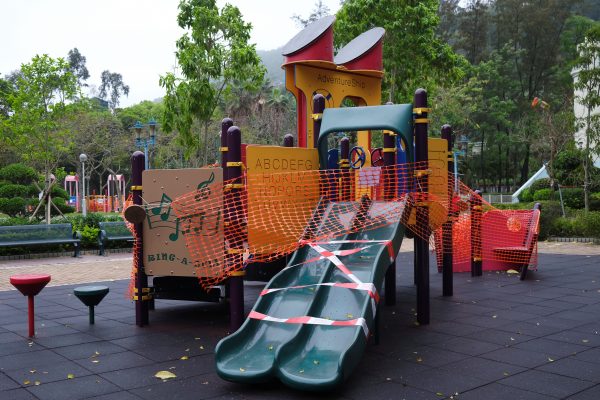After determining that ‘the risk of health impact caused by the novel infection on [the] local population in Hong Kong [was] high and imminent’, the government implemented a series of ‘emergency level’ measures based on a ‘containment strategy’ to stop the spread of the virus. This involved ramping up surveillance, relocating identified individuals to quarantine centres and acquiring emergency public health powers to enforce control measures.
To aid the quarantine and slow the spread of COVID-19, Hong Kong implemented a technology trinity of tracker wristbands, monitoring applications and confinement facilities. Neighbouring regions have had variable success in implementing similar technologies, including Singapore’s TraceTogether app and mainland China’s ‘close contact detector’. But the biosocial and geopolitical pressures in Hong Kong are especially acute given the ongoing protests against a series of unpopular regulations perceived to curtail fundamental rights and freedoms guaranteed in the Basic Law (Hong Kong’s mini-constitution). These include a controversial extradition bill that brought millions onto the streets in June 2019, the anti-mask law enacted on 5 October 2019 to prevent individuals from concealing their identities, and most recently, the unilateral decision by China’s National People’s Congress on 28 May 2020 to impose national security legislation on Hong Kong.
Amid the dual health and political crises, Hong Kong’s quarantine technologies have raised a crucial question about the relationship between freedom and health. What began as selective quarantining of travellers from high-risk regions has now expanded to compulsory testing of all incoming passengers. Testing is followed by hospitalisation of all confirmed COVID-19 cases. Fourteen days of quarantine in confinement centres is required for close contacts of confirmed cases, or at home for all other incoming passengers. Those allowed to return home must wear a tracker wristband paired with a mobile monitoring application during the quarantine period.
Both Hong Kong domestic and international media have been questioning whether the tracker wristband technology even works. An early version of the tracker wristbands (issued en masse when home quarantine became mandatory for most incoming travellers on 19 March 2020) seemed to be little more than laminated strips of paper printed with QR codes.
A subsequent Bluetooth-enabled tracker wristband seemed more robust, with black boxes mounted on rubber straps. But the straps of this second version could be pulled off, enabling an easy circumvention of quarantine regulations. This was partially offset by phone calls from public health workers requesting temperature readings and wristbands to be scanned by the phone application.
But we need to go beyond a narrow technical view to understand the broader biosocial efficacy of the wristbands. Social media applications, online videoconferencing and real-time surveillance trackers function as ‘virtual technologies of care’ in a time of viral crisis. In Hong Kong, quarantine wristbands are a material manifestation of an active public health bureaucracy, even if they are simply strips of paper. The wristbands are linked to a broader system of social contact tracing, universal medical care for all confirmed COVID-19 cases and isolation procedures for those at risk of infection. But do these quarantine technologies betray a more sinister politics of care?
Tracker wristbands, surveillance applications and mandatory quarantine facilities are abhorrent to most western liberal democracies. But the dichotomy between freedom and health may be a false one. People in Australia, Europe and the United States living under national lockdowns or shelter-in-place orders have experienced even greater infringement on personal liberties. Some are even participating in rallies to push back against such restrictions and to reopen local economies.
Concerns over quarantine tracker technologies must be evaluated against the current use of normalised surveillance technologies. Personal digital devices used on an everyday basis, including smartphones and fitness trackers, expose users’ movements, heart rate and other information to the companies who sell these consumer goods. Such information may also reach their affiliate businesses, third-party marketers, academic researchers, law enforcement personnel, government entities, private security experts, hackers and unknown others.
In what ways have we already accepted intrusions into our private lives and limits on our freedom in the name of convenience, commerce, pleasure or leisure? Is doing so for public health reasons so distasteful? Hongkongers have been subjected to infection control measures, including social distancing regulations and prohibitions on gathering, but their ability to go shopping, eat at restaurants, visit hair salons and walk around the city has remained relatively unfettered over the past several months.
Hong Kong’s approach of selective quarantining of high-risk individuals such as recent travellers and close contacts of confirmed cases allows the majority of the population to avoid lockdown. Sacrificing some freedom in the name of health may ultimately allow for more of both in the era of COVID-19. But in the context of widespread mistrust, Hong Kong’s government must ensure that the implementation of these technologies is transparent, secure and does not expand beyond their original purpose.
Joseph Walline is Assistant Professor in the Accident and Emergency Medicine Academic Unit at The Chinese University of Hong Kong (CUHK). He is a former US Fulbright Scholar with 15 years of research and clinical experience in the United States, mainland China and Hong Kong.
Priscilla Song is Associate Professor in the Centre for Humanities and Medicine at The University of Hong Kong (HKU). She is the author of Biomedical Odysseys: Fetal Cell Experiments from Cyberspace to China (Princeton, 2017).
This article is part of an EAF special feature series on the novel coronavirus crisis and its impact.

